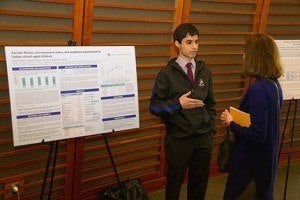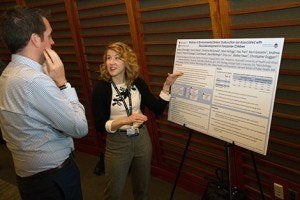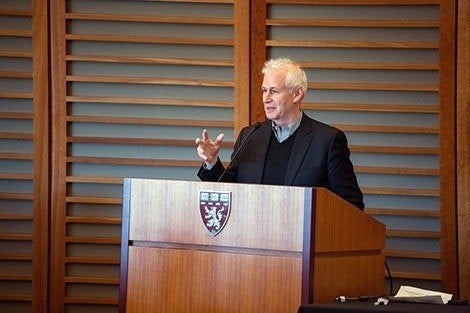April 3, 2015—It’s estimated that half of the 500 million children in low- and middle-income countries will face physical or cognitive developmental challenges. That eye-opening number set the tone for the second annual State of Global Health Symposium on Wednesday, April 1 at the Joseph B. Martin Conference Center. The symposium, Striving and Thriving: A New Era in Global Child Health and Development was co-sponsored by the Harvard T.H. Chan School of Public Health Department of Global Health and Population and the Harvard University Center on the Developing Child. Experts on early childhood development from Harvard and institutions around the world discussed the risk factors and potential interventions that affect a child’s ability to lead a healthy and prosperous life.
Following the panel discussion there was a poster session, where students presented their own research on early childhood development.
Panelists widely acknowledged progress in the area of early childhood development, noting that the global annual number of child deaths declined from 16 million in 1970 to less than 6 million in 2015. Now there is a growing push to improve the lives of children beyond survival.
Measuring risk factors
During the symposium, panelists identified several risk factors affecting early childhood development: poverty, poor nutrition, infectious disease, toxic stress, violence, and lack of appropriate educational stimulation and caregiving. While researchers have been able to effectively identify these risk factors, measurement has proven difficult.
“It’s amazing how little we know about the relationship from those risk factors to broader measures of child development,” said Günther Fink, associate professor of international health economics at Harvard Chan. “For many of those risk factors the only outcome that researchers have systematically looked at is physical growth.”
Featured speaker Jack Shonkoff, Julius B. Richmond FAMRI Professor of Child Health and Development at Harvard Chan and the Harvard Graduate School of Education, and Director of the Center on the Developing Child, said this is a critical measurement gap.
“Early experiences literally shape the architecture of the brain,” said Shonkoff. “Early adversity creates biological memories that don’t go away. The right kinds of experiences build a strong foundation, and negative experiences literally disrupt [that foundation].”
Healthy children, healthy economy

Despite the challenges in measuring the impacts of intervention on early childhood development, the potential economic benefit is clear.
“Delays in early life are strongly predictive of educational attainment,” said Fink, adding that education is directly tied to future earnings, and those earnings increase when early life risk factors are eliminated. Fink estimates that the economic benefit, just through better education, would be about $162 billion for each group of children born during the same year in the developing world.
Shonkoff is urging researchers to take a different approach to measurement—borrowing lessons from Silicon Valley and the medical sciences to better evaluate the ways in which interventions can lessen the effects of early childhood risk factors.

“[Our measurements] could be much cleaner and simpler, but most importantly we could make much bigger impacts,” said Shonkoff, underscoring the importance of translating data into formats that policymakers can understand. “We need a much deeper understanding of causal mechanisms that are basically telling us why what we’re doing will work.”
Shonkoff told the audience not to lose sight of the big picture—that the best way to help children may be to improve the overall quality of life in the developing world.
“If we want to achieve breakthrough outcomes for children experiencing adversity, we have to transform the lives of the adults who care for them.”
Photos: Emily Cuccarese, Noah Leavitt
